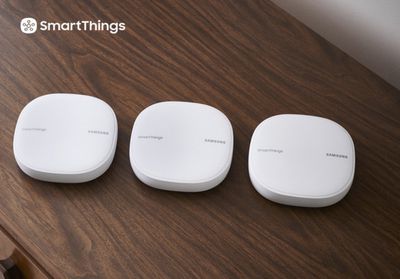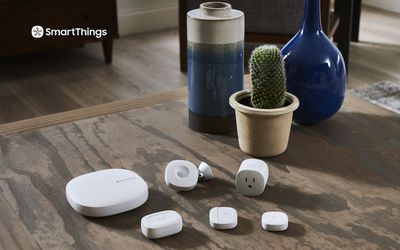The latest offering for users looking to add mesh networking to their homes has been revealed by Samsung today, called the SmartThings Wi-Fi (via The Verge). The router includes mesh networking technology from Plume, which itself recently revealed its "SuperPod" mesh router along with a $60/year subscription.
Samsung's SmartThings Wi-Fi isn't subscription-based, and in addition to the usual mesh networking features, the device also acts as a smart home hub for any SmartThings accessories. Similar to Apple TV and HomePod acting as a hub for HomeKit, SmartThings Wi-Fi will allow customers to set up and manage SmartThings-compatible plugs, switches, lights, cameras, and doorbells from Philips, Ring, Arlo, Kwikset, and much more.

With Plume's technology, SmartThings Wi-Fi learns the environment to optimize performance for consistent coverage throughout the home. The system is sold on Samsung's website in a 1-pack for $119.99 (covering 1,500 square feet) or a 3-pack for $279.99 (up to 4,500 square feet).
The company today also revealed a new standalone SmartThings Hub priced at $69.99, for those users who already have a router but still want to implement SmartThings products into their home. As an upgrade to the previous hub, the new device does not need to be plugged directly into your router and can instead work wirelessly anywhere in your home.

There are a few other SmartThings announcements that happened today, including upgrades to the platform's Motion Sensor, Multipurpose Sensor, and Water Leak Sensor. There's also a new SmartThings Outlet for $34.99 and a SmartThings Button for $14.99, all available to purchase on Samsung.com beginning today.
The SmartThings product launches today follow last week's Galaxy Note 9 reveal event, during which Samsung showcased its latest flagship smartphone. The company also detailed a new Galaxy Watch, Wireless Charger Duo, and Galaxy Home Smart Speaker.





















Top Rated Comments
I think it was Gruber or something he linked on Daring Fireball that had a good explanation: Apple used to make printers. They started making printers because all the printers out there sucked. Printers got better and they stopped making printers. The same applies to WiFi.
Other than that mesh WiFi networks are still just repeating a WiFi signal. Thus they have the same drawback. If it is only receiving at 50% strength. That node will be limited to the speed that signal can provide.
I still prefer hard-wiring all my access points. Then give them all the same SSID, encryption type and key. It takes a while to setup. But you get the best performance from AP that way. How often do most people change their SSID or any other WiFi setting? Although I don't buy actual AP. Using routers and disabling DHCP is cheaper.
The next best is Powerline adapters going to powerline access points. Works quite well. As I recall the utility TP-Link provides will allow you to apply the same settings to all Powerline AP on you powerline network.
Plus you don't have to log in through the vendor. I prefer to control my network directly.